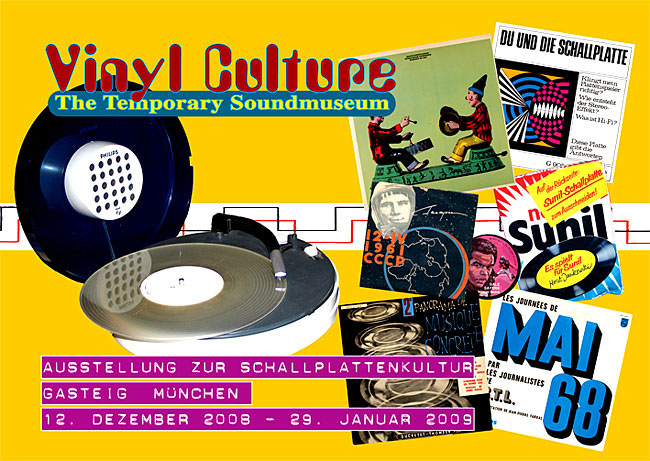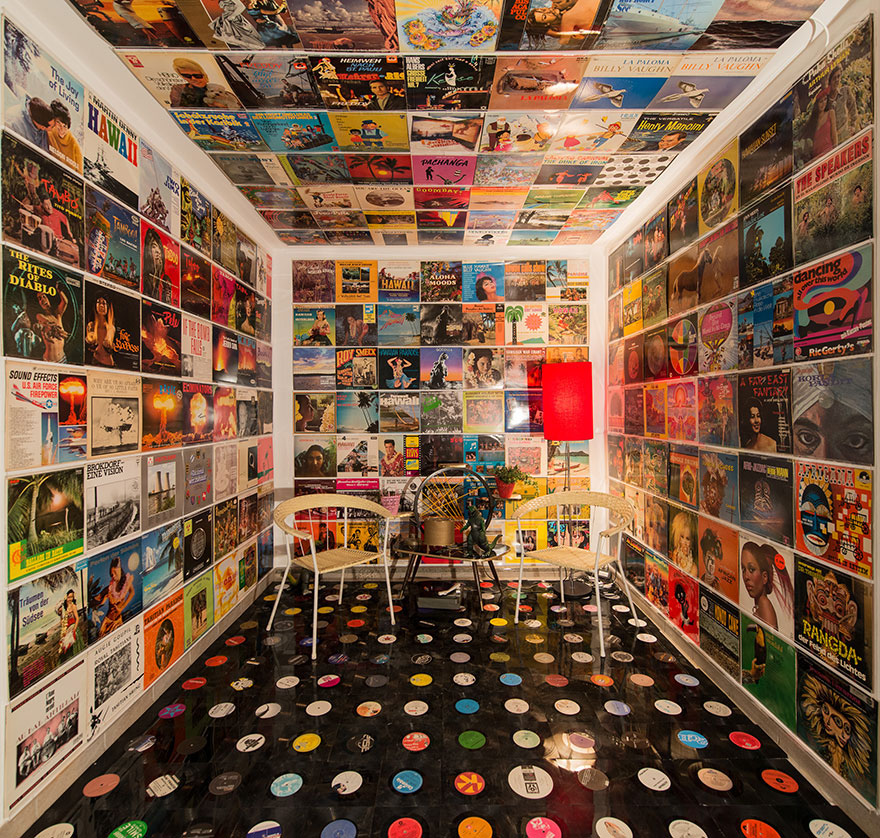Vinyl Culture

The Temporary Sound
Museum, Munich, Germany 2008
Munich,
Germany Vinyl Culture Exhibit - The vinyl
record is an "historic document, a vehicle for time-travel
and an inventory of the second half of the 20th century..."
Serendipity struck
during our Christmas visit to Munich
in 2008 when we went to a concert at the Gasteig and saw a
poster for "Vinyl Culture The Temporary Soundmuseum".
This exhibit was on the second and third floor foyers of a building
next to the concert hall so we made sure to see it. It included
500 objects (mostly phonograph albums and records) displayed in
20 cases. After returning home I found its website which displays
over 80 record players and many of the records. The following
introduction was written for the exhibit:
Along with the
disappearence of the vinyl record a special part of our culture
is vanishing, normally disregarded and not found worth of preserving.
Being part of pop and mass culture, records (and their relatives)
are not seen as a valuable cultural expression. And belonging
to the still neglected world of sound does not help either.
The exhibition Vinyl Culture tries for the first time to introduce
the record as a historic document, a vehicle for time-travel
and an inventory of the second half of the 20th century, unrestricted
by borders drawn by genre or nostalgia.
The Tempoary
Soundmuseum
The Temporary Soundmuseum is
a comprehensive and constantly expanded archive interested in
the vinyl culture conveying data and vibes of contemporary and
recent history.
The vinyl has always been a
medium not only of music but also of propaganda by everyone
with a message, political, religious, philosophical and other
aspects of weltanschauung.
The unusual archive comprises
areas like ethics, politics, military, art, environment, science,
advertisement, graphics and design, to records by the Muzak
Corporation and other rather uncollectibles (go to the text
archive for examples). It obviously consists mainly of records
and covers, but includes also all the different variants like
sounding postcards or flexis, fragile containers of all kinds
of elusive messages.
The small but exquisite collection
of about one hundred record players shows the various stages
of design and raises the question why all the colourful and
fanciful units of the 1960ies and 70ies were replaced all of
a sudden by boring black and grey boxes.
Every museum of design worldwide
displays the same Brauns and Bang & Olufsens, beautiful classics,
but less influential as far as our pop consciousness is concerned.
Click
here to view some of the soundmuseum's albums displayed
Courtesy of vinylculture.org
Here is the text
that accompanied "VINYL CULTURE: The Temporary Soundmuseum"
The Vinyl Record: a (mostly) black
disc, overwhelmingly present from 1950 -1990, declared dead
before the turn of the millennium, remembered as the medium
of pop culture and representing an era of recent history, seemingly
gone, but still not extinct, kept alive not only by djs, club
culture and collectors.
Undeniably the vinyl record represents an
important and even constitutive element of the cultural landscape
of the 2nd half of the 20th century. Compared to the cd, the
record was much more then a piece of material carrying randomly
recorded data. In a slight variation of Marshall McLuhan’s famous
quote one could say that it (sometimes) was the message itself.
Therefore the vinyl record was able to represent
much more then any other commercial sound container. Fashions
and attitudes were expressed, the cover alone was at the same
time promise, directory and independent piece of art.
Narrowing the attention on pop culture alone
though misses all the other messages, entrusted to the grooves.
It is one of the basic discoveries of The Temporary Soundmuseum
that there is hardly an acoustic statement of any kind not showing
up on a vinyl record. Literally everyone has tried to take advantage
of this once modern medium to reach a public beyond the lovers
of classical or popular music.
Thus a body of material of great cultural
and historical relevance has been generated whose importance
has to be acknowledged yet. The 'cheap' mass-production tends
to overshadow the 'valuable' cultural assets. While every still-
or moving picture (photography, film, video) is somehow understood
as part of a greater heritage (or at least the possibility of
an aesthetic reception is given at any time), everything concerning
sound is generally overlooked, adding to the reasons why the
vinyl record (including its relatives like flexies and singing
postcards etc.) is not valued as an object of cultural significance
or source material for researchers of recent history.
2014 Stranger
in Paradise Temporary Exhibit

2014 Stranger in Paradise
Temporary Exhibit
Installation.
287 Record Covers: Exotica, Pacific, Hawaii, Nuclear Power,
Godzilla. A floor made of vinyl records. Small table. Lamp.
Garden stools. Two Godzillas. Commissioned by the Kallmann-Museum
Ismaning 2014, for the group exhibition "Elswhere - Sehnsuchtsbilder
in der modernen Kunst (Depicting Longing in Contemporary Art)"
Visit
Vinyl Culture's Soundmuseum for
links (like 2014 Stranger in Paradise) for other temporary
exhibits staged since 2006 in various venues in Germany.

|